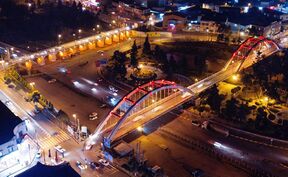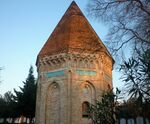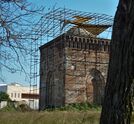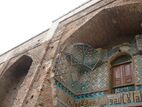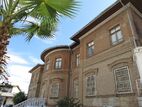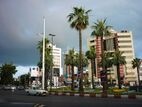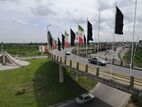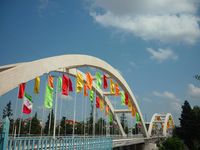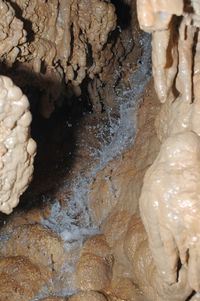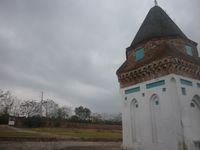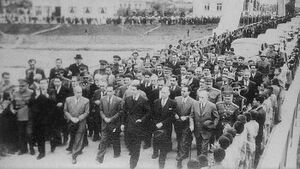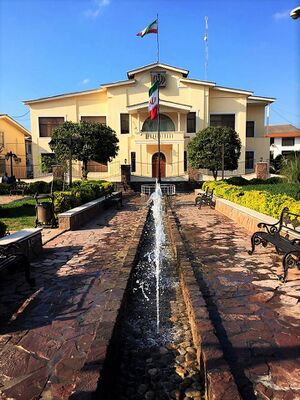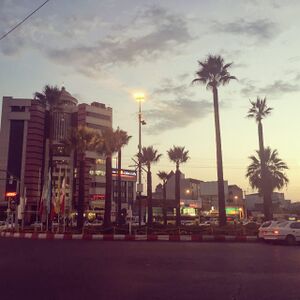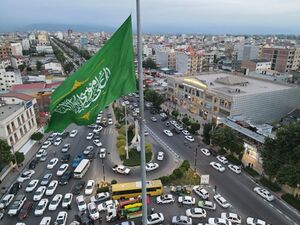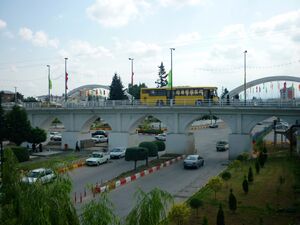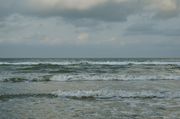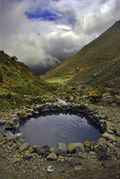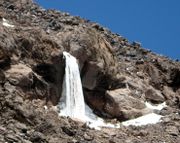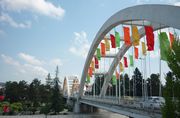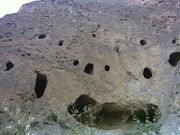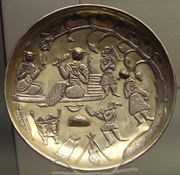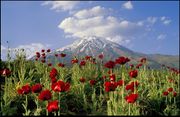آمل
Amol
آمل (فارسي) | |
|---|---|
مدينة | |
| الأسماء القديمة: Ask, Amardha, Amardian, Tabaristan, Amele, Amol | |
| الإحداثيات: 36°28′11″N 52°21′03″E / 36.46972°N 52.35083°E | |
| بلد | |
| المحافظة | مازندران |
| مقاطعة | آمل |
| بخش | الوسطى |
| أدرجت (مدينة) | 1923[1] |
| الحكومة | |
| • Mayor | أمير سليماني[1] |
| المساحة | |
| • مدينة | 21 كم² (8 ميل²) |
| المنسوب | 76 m (249 ft) |
| التعداد (2012) | |
| • مدينة | 224٬160 |
| • الكثافة | 11٬000/km2 (28٬000/sq mi) |
| • العمرانية | 364٬692 |
| منطقة التوقيت | UTC+3:30 (IRST) |
| • الصيف (التوقيت الصيفي) | UTC+4:30 |
| Postal code | 46131-46391[2] |
| مفتاح الهاتف | (+98) 121 |
| الموقع الإلكتروني | amol.org.ir |
آمل هي مدينة في محافظة مازندران في إيران وهي من أكبر مدن المحافظة ويبلغ عدد سكانها 197470 نسمة (عام 2005). ترتفع آمل 76 متراً عن سطح البحر، ويبعد مركز آمل عن شاطيء بحر قزوين 18 كم وعن أقدام سلسلة جبال البرز حوالي 6 كم. كما تبعد آمل حوالي 180 كم شمال شرق مدينة طهران. كما تتمتع آمل بموقع مهم فهي المدخل لعدة مدن في محافظة مازندران. تتبع مدينة آمل العديد من القرى ذات الطبيعة الجميلة كما يمكن رؤية قمة جبل دماوند من مدينة آمل.
تاريخ
 مقالة مفصلة: تاريخ آمل
مقالة مفصلة: تاريخ آمل
بدأت مظاهر الحضارة والتمدن فی آمل ومنطقها خلال قوم آمارد علی أرجح الأقوال.وكان اسم آمول من قبيلة من قبائل الآمارد، و حسب احصائيات المدينة الموجودة اليوم في محافظة مازندران في إيران بأنها كانت عاصمة سلالات عدة کبیرة. وکان من المعروف أن آمل يقصدها العلماء والفلاسفة من المدن والعاصمة ومعاقل الإسلام لفترة طويلة من الزمن.
Pre-Islamic
Ammianus Marcellinus says the name the Amol city is derived from the people Amard.[3]
Amol is one of the most ancient cities of Iran. A number of historians and geographers believe it was established in the 1st millennium BC. Some historians have attributed the rise of the city during the reign of mythological king Tahmuras.[4]
Pishdadian and Amard
Some historians have associated this ancient city with the periods of the Pishdadian dynasty and the Kayanian dynasty. Amards were the people inhabiting the area before the arrival of Aryans, who had migrated to and settled on the Iranian Plateau from the late 2nd millennium BC to early 1st millennium BC. Many scholars believe that the city's name is rooted in the word Amard (Amui in Pahlavi).[5] Amol is an old city, with a history dating back to the Amards. According to historical literature, Amol was the capital of Mazandaran, at least in the period starting from Sassanid Empire to the Ilkhanate dynasty of Mongol Empire. Though they are a Median tribe, Herodotus names a tribe called Mardians as one of the ten to fifteen Persian tribes in Persis. It is now known that the only distinction between the Median Amardians and the Persian Mardians is the 'a' in the beginning of Amardians, which would mean they are two different tribes. Elsewhere he says, one of the peoples who have trusted Darius I[6]
Igor M. Diakonoff says, Amardian lived in the coasts of the Caspian Sea, in the distance of the Alban and Otia from the north and the Hyrcanian from the east.
Strabo says about the Tapyri that they wore black robes and had long hair, and "he who is adjudged the bravest marries whomever he wishes" (Geography 11.8 = T520a). In the history of the Persian Empire, the Mard were handsome, capable and brave persons presented in the heart of the army and were responsible for defending the commander.[7])he Amard helped Achaemenid in several battles including the invasion of Greece, the occupation of Sardis, the attack of Medes and at the Battle of Opis. The other theory about Amol via Ibn Isfandiyar says, at the request of wife Firoz Shah, he created a large and flourishing city named Amele.[8]
Achaemenid Empire
People of Amol were the people of Amard they were one of the most important Achaemenid satraps who were the guardians of the Amard Sea, the current Caspian Sea.[9] Further evidence of the power of the Amol people is their fighting in the Battle of Thermopylae, Battle of Gaugamela and other Sardis forces in the Achaemenid Empire.[10] Quintus Curtius Rufus said, Immortals (Achaemenid Empire) Archers they were all Amard people.[11]
Parthian Empire
During the age of the Parthian Empire, Amol was one of the centers of Iran. It seems that Amol's reputation in the time of Alexander the Great and the Parthian period dominated the political-administrative Satrap was Hyrcanian.[12] During the Parthian period, Amol was also famous and prosperous, which was called Homo or Hamo. Parthian King Phraates I (171–173 AH) defeated the Mardas in the Amol region. He is said to have moved a group of people to the Parthian lands in northern Khorasan and settled in western Amu Darya, also known as Amol Zam.
Sassanian

According to historical literature, Amol was the capital of Mazandaran during the period starting from the 3rd century AD under the Sassanian Empire to the 13/14th century AD under the Ilkhanate dynasty of Mongol Empire. Before Islam, Amol was one of the largest and most important cities in the region and was considered the center of Mazandaran. The city of Amol existed before the Sassanids and during the Alexander period. During the Sassanid period, the importance of this Amol was increased due to the escape of the followers of Mazdak to this city. Based on pieces of evidence, including the coins found during excavations in addition to Muslim historical books, Amol was the capital of Mazandaran province during the Sassanid Era. According to historical literature, Amol was the capital of Mazandaran during the period starting from the 3rd century under Sassanian Empire to the 13/14th century under the Ilkhanate dynasty of Mongol Empire. On Sasanian coins, coin cities where there has been abbreviated name is known, but mark m was Amol. During the Bahram V Amol were Central of Iran and at during the Khosrow II and Dabuyid dynasty capital Mazandaran. Amu Darya Sasanian mid pers river about 2,500 km long, regarded in ancient times as the boundary between Iran and Turan, the modern name may be derived from Amol.[13] In city during this period has Temple, Market, fireplace there was. Ibn Rawi in his book calls Amol bigger than Isfahan and Qazvin.[14]
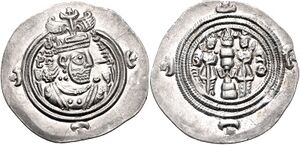
In Hudud al-'Alam says about Amol, is great city with most moat and castle, the universe and origin of merchants and at city Carpet, mat, boxwood, bowl, brick and medallion is found.[15]
Herodotus in Histories say, mentions the tribes of the Tabaristan the Mard or the Amards In the time of the king Darius the Great from influential and tribes people. During the Sassanid period, the city of Amol enjoyed development and was the center of the important province of Tabarestan. During its development, the city had infrastructures and elements such as government citadels, neighborhoods, fire temples and bazaars. During this period, Amol had a fire temple in the area, called name Avam Kuye.[16]
Dabuyid dynasty and Bavand dynasty Iranian dynasty, were the kings of the Sassanid dynasty, they lived in Amol and it was the city capital of these dynasties.[17] The coins of Ispahbudhan of Tabarestan and the Arab and Sassanid periods have been minted in Amol mint and sometimes in Sari. It can be argued that the mints of several cities in Mazandaran, especially Amol and Sari, such as the city of Gorgan, was have been engaged in minting various coins for 1,300 years.[18]
Islam
Abbasid, Alid, Ziyarid, Marashis
Amol, in the era of the Alid dynasties and Marashis dynasty, was the capital of Northern Iran. The inhabitants of Amol embraced Islam during the reign of Mahdi (775–785), the Abbasid Caliph. Amol was also the capital city of the Bavand dynasty and Ziyarid dynasty. The people of Amol initially resisted the Arabs. In the Abbasid Caliphate of the ninth century, Amol was one of the largest cities in Iran. Khalid ibn Barmak built a palace in the city and ruled for years. People from the Qarinvand dynasty arrived a couple of years and fought with the Abbasid Caliphate to win the kingdom. During the Umayyad Caliphate period, during the reign of Muawiyah I, Sa'id ibn al-As undertook the conquest of Tabaristan, and with an army of 4,000 troops rushed there, and the whole war between him and Farrukhan the Great lasted for two whole years, but was postponed. The conflict lasted until Abbasid Caliphate until the attack of the Persian general Wandad Hurmuzd.
In Hudud al-'Alam, Amol is regarded as a great city with active commerce and trading ventures.[19] However, resentment with the Tahirids rule increased due to the oppressive activities of their officials. People of the provinces pledged alliance to Hasan ibn Zayd. Zayd became the founder of the Zaydid dynasty of Tabaristan Alavids government in Tabaristan established and it's with Amol centered and 106-year domination of the Abbasids in the territory ended.[20] Yaqub ibn Layth the was geostrategy in Amol. Hasan al-Utrush with a trip to Amol who re-established Zaydid rule over the province Tabaristan in northern Iran in 914, after fourteen years of Samanid rule. After the Alid dynasty, the Ziyarid dynasty ruled Iran and Tabaristan. At this time Amol was developed in such a way that geographers have written articles about the industry and its silk.[21] Hasan ibn Zayd, nicknamed al-Dai al-kabir, appeared in the Tabaristan region in 250 AH, and many dissatisfied people and the captives of the Caliph Tahirid strengthened him. He invited people and published the Shiite religion. After coming to power in Tabaristan, Daei Kabir moved his capital from Sari to Amol, which was Taherian's seat.[22] In 260 A.D., Ya'qub ibn al-Layth al-Saffar marched on Tabaristan and entered Amol after the departure of Hassan ibn Zayd, but his rule did not last long and the Alavids recaptured the city again. The Alawites ruled the city until Ziyarid and Buyid, who were the handmaidens of the Shiites. The people of Amol were very militant and stood up to the Arabs, but social injustice and class divisions led the people to convert to Islam.[23]
Qabus was in 1012 overthrown by his own army, and was succeeded by his son Manuchihr, who quickly recognized the sovereignty of Mahmud of Ghazni, and married one of his daughters. Manuchihr died in 1031, and was succeeded by his son Anushirvan Sharaf al-Ma'ali whom Mahmud of Ghazni had chosen as the heir of the Ziyarid dynasty. From 1032 to 1040, the real power behind the throne was held by Abu Kalijar ibn Vayhan, a relative of Anushirvan Sharaf al-Ma'ali. During this period, Amol was chosen as the capital of Iran and until 1090. He also the first seminary by Hasan al-Utrush built in Amol, which was later named Imam Hassan Askari Mosque. The subsequent Afrasiyab dynasty flourished in the late medieval, pre-Safavid period; it is also called the Kia dynasty. It was founded by Kiya Afrasiyab, who conquered the Bavand kingdom in 1349 and made himself king of the region, in Amol.[24][25] In this period Sheikh Khalifa Mazandarani of Amol, was a leader Sarbadars.[26] Amol during the ministry of Khajeh Nizam al-Mulk Tusi in the Seljuq dynasty, along with the big cities of that time, the Islamic world Nishapur, Balkh, Herat, Baghdad and Isfahan had a prestigious Nezamiyeh modern school.[27]
Safavid
In time of the Safavid rulers of Mazandaran, Amol experienced a period of growth. The city was the favorite dwelling of Abbas II of Persia, who often frequented it. At the time Amol was considered "the capital of the inhabited world" and acclaimed for its grandeur. Several bridges were built in the area, across the Haraz river, at this time. During the Safavid era, especially during the reign of Abbas the Great, Mazandaran was considered and a road from Astarabad and Sari to Amol was built.
in town was founded through trade center position and business centers already exceeded and founded artillery. The town has spacious and well-supplied bazaars and post and telegraph offices. Excavations in Amol at Hall of Fame have uncovered glazed ceramic and glass belonging to Islamic and modern periods[28] But after the Mongol invasion, the region was subject to devastation and it was during this time that Sari was declared as capital. In the beginning of the 7th century, Hessamedin Ardeshir, shifted the capital from Sari to Amol and constructed his palace there. At this time, a Palace and Ab Anbar was built by the order of Shah Abbas, and the tomb of Mir Ghavam al-Din (Mir Bozorg), which had been destroyed by Timur's agents, was magnificently rebuilt.[29] Amol recovered a certain measure of prosperity while ruled by the Marashiyan and the Safavids under the latter it was a center of the province of Mazandaran. Since then it has never played a leading part in Persian national affairs, being surpassed in population by Babol and by the administrative capital of the province Sari, it has also suffered at various times from earthquakes. In continuation, Haraz River crosses the city of coal and iron mining region of Amol much iron can also have it in the past.[30]
Afsharid
Amol in Afsharid dynasty and Zand dynasty as a city for trade and construction were instruments of war. In During the Nader Shah in town was founded Iron plant through trade center position to make cannonballs, mortars and horseshoes and business centers already exceeded and founded artillery. This was the first artillery workshop in Iran[31] Jonas Hanway came to Iran at this time and visited Amol and says about this city, Due to the abundance of iron ore mines, by Nader Shah order, Amol it became the most important foundry and steel plant, where cannonballs, rifles and horseshoes were produced, and Nader Shah it was even decided to build the Iranian Navy in Amol.[32] At first, the people and rulers of Larijan[33] and Amol, in support of Zand dynasty, resisted Agha Mohammad Khan Qajar and defeated him.
Qajar
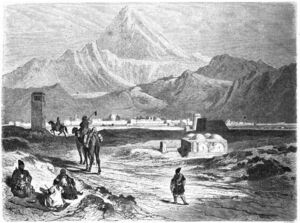
In the Qajar era, road and railway from Tehran to Amol, Amol was pulled from Mahmoudabad. Ibn Hawqal says, the geographers of the 4th to 10th century describe Amol great prosperity and prosperity, in the latter respect, according to Ebn Ḥawqal, it surpassed Qazvin. Its inner city was protected by a moat, and the houses were constructed of wood and reeds rather than mud bricks on account of the heavy summer rainfall. Rice, fruits, and vegetables grew profusely, and the town was a center for the fabrication of wooden articles, textiles, and carpets, the silks being especially famous. Amol port on the Caspian was the little town of named Ahlam or Ahlom.[34] James George Frazer entered Iran in 1238 as a merchant and scientist and said about this city in his travelogue, the city truly great and vast. people were decent and respectable inhabitants of the city. Several leaders of the Iranian constitutional revolutions of 1905 and 1911 hailed from Amol. Mulla Ali Kani, one Amoli people reformist who led the people, had a great role in achievement to the goals of Iran's constitutional revolution. During this period, was built many homes in the city. Although today Amol has expanded greatly on both sides of the Haraz river, its functions are still the same as they were seventy or eighty years ago.[35] The Amol cotton cleaning plant was built in 1906 by the Russians. Prior to that, two company Rosenblum and Osser in one of Amol borough that is, Barforoush was active.[36] In the 19th century, Amol iron and iron goods were traded all over Iran and as far abroad as Baghdad, Mosul and Damascus. Today, the main industries are food processing factories rice, minor woodworking shops, and a few brickworks.[37] Pierre Amédée Jaubert say, the Dispatch ambassador Napoleon Royal court Fath Ali Shah Qajar visited Amol and mentioned in his book about the Haraz River and the centralization of Steel workshops on its shores.[38] Although today Amol has expanded greatly on both sides of the Haraz river, its functions are still the same as they were seventy or eighty years ago. Besides being one of the county centers of the province of Mazandaran, it is a busy commercial center. In itinerary book says, Amol is a magnificent city with 4 gates, although there is no gate installed, namely Darvaze Tehran or Larijan, Barforosh, Taliksar and Nur.[39]
After the fall of the Mongols, the Marashians appeared in Mazandaran. In 760 AH, Mir Ghavam al-Din Marashi established the Marashis government. The Marashis uprising began in Amol. After gaining power, the Marashians soon occupied all the lands and areas around Mazandaran and expanded their territory from Gorgan to Qazvin and Isfahan.[40][41]
In interval Persian Campaign, Community Tabaristan by Amir Movayed Savadkoohi, with, the support Influential men of Amol, founded to oppose the British and the Russians. Vsevolod Starosselsky in Amol build a Headquarters for capture it other cities in Mazandaran. Mirza Kuchak Khan To deal with him, entered Amol through the port of Ahlam with Khan's Amol and left the city after a long involvement against Persian Cossack Brigade.[42]
In this epoch, with the support of the Shah and the wealth of Amin al-Zarb, the first modern railway in the history of Iran was established in Amol.[43] Twenty-one kilometers of railway linking Amol and the iron mines of Mahan Nour to the Caspian port of Mahmoudabad in the name of Naseriyah. In 1887, the project prompted of Amin al zarb after three visits to Europe and the contract for the construction of the railway was signed with the British company Quzi and a Belgian company. In the end of the reign of Naser al-Din Shah Qajar, railway it was completed in 1891 but never used due to the involvement of local people and Russians. About 700,000 tomans were invested for project.[44][45] Following the development technocracy policies of Iran by Amin al zarab, was established the first Steel mill of Iran in Amol. In 1887, Amin al zarb obtained an exclusive permit from Nasser al-Din Shah for 30 years to establish a smelter, and bought an eight-meter furnace with a production capacity of 15 tons of iron from France on for 24-hour and settled in Amol.[46][47]
20th century
Pahlavi, Islamic Republic of Iran
During the reign of Reza Shah Pahlavi, the face of the town was changed drastically. Schools and most of the streets and governmental buildings current Amol date from that era. During this period, by the order of Reza Shah, Austrian and German engineers, they built Moalagh Bridge, Municipal mansion, Municipal hotel, Chaikhori palace, Pahlavi high School, Asset building and Rice warehouse for export. During this period, the construction of an alternative Haraz road, it was handed over to the Russian company Treskiniski by the Reza Shah.
Hyacinth Louis Rabino, with visiting Amol during this period, described Amol as an open town with four gates, nine-quarters, and approximately 2000 houses. A large bazaar contained about 400 shops with many traditional crafts and trades.
In the during Mohammad Reza Pahlavi, The construction of Taleb Amoli Street in the western part of the old city and its extension in 1973 to 1975 was completed and the texture of the city was changed. Street Shahpur, Street Reza Shah Kabir, Street Farhang, Street Saadi, Shir-o-Khorshid Hospital, Imamzadeh Abdollah and Spinning, weaving and textile factories were built. Road 77, Sepah-e danesh school, Paddy factory, Grundig and Kubota in Iran it came to fruition in 1963. Supporting Abali hotel, Rineh tourism center and Reinforcement of Amol port it was done as a tourism project. During this period, the municipal sewage system and electricity were modernized.[48] During this period, behest to Reza Shah the railway between Tehran and Amol began seventeen years ago, and gradually a large part of it was built, except for sixty kilometers between Abegarm and Amol, Which totally stopped construction in September in the beginning Anglo-Soviet invasion to Iran.[49] In the end of the kingdom an agreement was signed between the Ministry of Agriculture of the Pahlavi Government of Iran and the Ministry of Economic Affairs of the Republic of China on the extension of agricultural technical cooperation to develop research and increase rice production, and was implemented at the Amol Rice Research Institute of Iran.[50]
With the beginning of the Islamic Republic of Iran The forest uprising implement. The Jungle Uprising in 1982 of the Union of Iranian Communists (Sarbedaran) mobilized its forces to jungles around Amol and started some wars against the Islamic Republic in those jungles. It finally organized a famous uprising on January 25, 1982. The Communist Union, based on its Maoist policy, and with its mindset of guerrilla and peasant wars, establishment on the outskirts of Haraz Road pathway of several important provinces and cities of the country and suitable camouflage of Amol forest and mine reasons to choose in the forest its strategy for war. the union has assassinated 600 people during three operations in Amol in November 9 and 13, 1981 and January 25, 1982. the Mojahedin used machine guns and rocket-propelled grenade launchers against units of the Pasdaran. Smaller left-wing opposition groups, including the Organization of Iranian People's Fedai Guerrillas, attempted similar guerrilla activities. In July 1981, members of the Union of Communists tried to seize control of the town of Amol. This uprising was a failure and most of the Maoist and UIC leaders were hanged but the uprising itself became very famous and is well respected among some Iranian Leftist organizations. It also experienced various theoretical and political crises. The clashes lasted from November to February for four months.
This day became known in the Iranian calendar named Epic 6 Bahman or Epic of the People of Amol.[51] After this incident, Ruhollah Khomeini only mentioned the name of the city of Amol in political and divine testament and wrote, We have to thank the people of Amol.[52]
21st century
Some of the most recent projects have been the complete restoration of the Bazaar and of the Imam reza street, as well as a comprehensive plan for the preservation of the old city quarters. A lot of different construction projects are currently underway, which intend to modernize the city's infrastructure. In the last few years, many square, towers, boulevards and bridge were built in Amol. For example, Haraz Street one of the most modern streets of northern Iran. Amol is growingly turning into an industrialized town like most of the Iranian large cities. Today, Amol is a thriving metropolis. One of the things they really lack is an airport so there are no cheap flights to Amol. Some of the most famous companies in Iran have main offices located in this city. Good secondary and tertiary education is being offered here as well. Islamic Azad University, for instance, is one of the biggest universities in the Middle East. Now in Amol there municipality and special governor. Amol is one of the research centers for scientific development, knowledge-based sciences and Science and Technology Park of Iran. At present, Amol, as the center of dairy and livestock products, mining sand, nurture products such as meat, flowers and fish and production rice of Iran. It Industrial machinery products is also very popular in Amol and Iran Heavy Diesel Factory is located in Amol Industrial Town.[53]
At present especially since 2017, in addition to mass construction of residential buildings, the construction of small streets and hall sport in the deprived areas of the city has accelerated.[54]
Bitter events
- Amol Gullies were completely destroyed. Since Sasanian Empire then the town has suffered earthquake and flood damage several times, but each time has recovered, and it is still a considerable town. During the Pahlavi dynasty, the city was burned twice due to fire.[55][56][57][58]
- Flooding in Mount Deryouk, and the destruction of entire city.
- Dangerous diseases that plague the year 1198 AH
- The outbreak of the dangerous plague that took place in 1198 AH destroyed countless civilians
- The war of the local kings with the Arabs
- Mongol invasion of Genghis Khan and his descendants to Tabaristan
- Wajih ad-Din Masud attack in Amol
- Battle Alavid and Saffarian Samanid in Amol
- Battle House of Karen and Bavandids in city
- Samanid Empire attack to royan and Amol with House of Ispahbudhan
- Timur war with the kings Marashis and killing people and battle with Iskandar-i shaykhi
- Attack Mas'ud I of Ghazni on the city
- Shah Ismail I and Shah Abbas Safavid King wars attack the Amol and killing people
- Agha Mohammad Khan Qajar attacked the Larijan and Amol, killing people and destroy the city
- Conflagration in 1335 AH which caused a lot of damage and severe destruction of the city. This fire and fire occurred in the year 6 AH, which first started near the Niyaki ridge and was swept across the city by the wind and reached the Haraz River and caused a fire to the gunpowder shop and ammunition shop. The shop exploded and a terrible fire broke out across the river, and then the whole city of Amol was blown away by the wind. It is known that the fire took place in April, when residents were enjoying the Nowruz celebration, and much of the city was turned gray
- Sangchal (Bandpay) earthquake of July 2, 1957
- Destroying people with Disease glanders
First of Iran
- The first steel mill in Iran[59][60][61]
- The first artillery and gunpowder workshop in Iran[62]
- The first foundry in Iran[63][64][65]
- The first modern railway in Iran[66][44]
- The first banknote printing factory in Iran[67]
- The first road building in Iran[68]
- The first commercial port in northern Iran[69][70]
- The first cotton gin factory in Iran[71]
- The first mineral water factory in Iran[72]
- The first mdf wood factory in Iran[73]
- The oldest seminary in Iran[74]
المناخ
| بيانات المناخ لـ Rineh Lar, Amol | |||||||||||||
|---|---|---|---|---|---|---|---|---|---|---|---|---|---|
| الشهر | ينا | فب | مار | أبر | ماي | يون | يول | أغس | سبت | أكت | نوف | ديس | السنة |
| Source: Iranian Meteorological Organization[75] | |||||||||||||
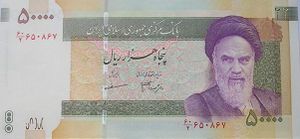
عدد السكان
يبلغ عدد سكانها200000.
مشاهیر الآملیین
سکن في آمل، الإمام مسلم صاحب صحيح مسلم والحاکم صاحب المستدرك، كما نسب إلى هذه المدينة الكثير من العلماء وفلسفة وأدباء وشعراء منهم:
- محمد بن جرير الطبري
- العلامة حسن حسن زاده الآملي
- أبو سهل القوهي
- الامام فخر الدين الرازي
- العلامه عبد الله الجوادي الآملي
- اللالكائي
- عمر بن الفرخان الطبري
- أبو الحسن الطبري
- المازيار بن قارن بن سروین
- الرکن الدین الآملی
- ابن ربن الطبري
- علي لاريجاني
- ترنجی الطبري
- مولانا صوفي
- الشیخ قیس الرازي
- الشیخ محمد تقی الآملی
- آیت الله میرزا هاشم الآملی
- فخر الاءسلام
- عبد الله مازندراني
- البروفسور احمدیه
- سید رضي الاریجاني
- سید الأبوا لحسن شمس آبادي
- الظهیر الدین مرعشي
- مولانا کاشي
- محمد تقی دانش بزوه
- ملک الشعراء طالب الآملی
- محمد بن محمود الآملي
- محمد بن بندار بن محمد اللارجاني الطبري
- أبوالعباس قصاب الآملی
- ملا صالح مازندراني
- اسماعیل خواجوي
- شیخ الخلیفه السلطان
- ابن الاسفندیار
- عماد الدین طبري
- مولانا سراج الدین قمري
- قاضي الهجیم الآملی
- سید علی ابن محمد الآملی
- بن رستم الطبري
- الاستاد فرهنگ شریف
- یحیی ابن ابی منصور
- خلیل بن بکر الآملی
- سهل بن بشر
- الحاج ملا علی کني
- الشیخ الکیلانی
- أبو حاتم محمود بن الحسن الآملی
الأماكن السياحية والثقافية
- جبل دماوند
- جسر دوازده چشمه
- جسر معلق
- السوق القديم
- قلعة ملک البهمن
- مقبرة میر حیدر آملی
- حراز نهر
- لار السد
- آتسکده آمل
- موزه التاریخ الآمل
- قبر ناصر الحق الزیدیه
- مقبره میر بزرگ المرعشي(قوام الدین مرعشي)
- قدمگاه خضر
- غابة الیمستان
- غابة زیارو
- غابة بارک جنگلی هراز
- بقعه الإمام زاده عبد الله
- الكهوف البيوت القديمة کافر کلي
- بقعه الإمام زاده ابراهیم
- بقعه الشیخ درویش
- بقعه السید حسن ولی
- مسجد حاج علی کوجک
- مسجد آقا عباس
- حمام الاشرف السلطان
- کاوانسرا کمبوج
- شلال یخی
- شلال الآمل
- مسجد الامام حسن العسگري
- قلعة کهرود
- قلعة امیری
- شلال لار
- شلال سنگ الدرکا
- أبرز دور الملك ناصر الدين القاجاري
- أصفر زهرة الكهف
- شلال شاهاندشت
- شلال دریوک
- حمام شاه عباسي
- المياه الساخنة والمياه المعدنية لارجان
- المياه الساخنة والمياه المعدنية استرابکوه
- المياه الساخنة والمياه المعدنية اسک
- قديم المنازل والقصور داخل المدينة
لغة السکان
لغة أهل المدينة هي الفارسیه باللهجه الآملية.كما ويتحدث فيها السكان الترکية والکردیة بلهجة جدلية فهذه المدينة خاصة وفريدة من نوعها للتعددية الموجودة فيها.
موقع المدينة
الكليات والجامعات
المدرسة النظامية من مدارس جهان القديمة، ولهذه المدرسة شهرة عظيمة وكانت الذي أنشئ في سبع مدن في مختلف أنحاء العالم، وأيضا من بين سبع مدن من كان أيضا تأسست امول امول في.
- جامعه شمال
- جامعه العلوم الطبيه
- جامعة العلوم الطبيعية
- جامعه ازاد الإسلامية آیت الله آملی
- جامعه انستیتو
- جامعه بیام نور
- جامعه التقنيه والهندسه
دین
الإسلام هو دین الأول فی آمل
معرض الصور
Mount Damavand, 5,610 m, the highest point in the Middle East
المدن الشقيقة
المصادر
- ^ أ ب Official website
- ^ Iran Post Website. Postcode.post.ir (2011-07-11). Retrieved on 2012-03-01.
- ^ "Amol Government". Archived from the original on November 28, 2016. Retrieved November 28, 2016.
- ^ Amol origin at Hamshahri
- ^ Eurasia book / 178.2
- ^ "Amol". eurasia.travel. Archived from the original on December 1, 2017. Retrieved July 29, 2020.
- ^ "ARMY i. Pre-Islamic Iran – Encyclopaedia Iranica". iranicaonline.org. Retrieved July 29, 2020.
- ^ Tabaristan History Book, Page 191
- ^ The Persian Empire: A Corpus of Sources from the Achaemenid Period
- ^ Ancient history of Iran in foreign wars / 447.
- ^ The Hyrcani had mustered 6000 as excellent horseman as those nations could furnish, as well as 1000 Tapurian cavalry. The Derbices had armed 40000 foot-soldiers; most of these carried spears tipped with bronze or iron, but some had hardened the wooden shaft by fire. Curtius Rufus Quintus, history of ALEXANDER (3.2.7)
- ^ Parthian History Book by Igor M. Diakonoff
- ^ Encyclopædia Iranica -Amudarya
- ^ Book History Sassanian Emp
- ^ ḤODUD AL-ʿĀLAM – Encyclopaedia Iranica
- ^ Herodotus (1987). The History, translated by David Gren. University of Chicago Press. ISBN 0-226-32770-1. pp. 37–38.
- ^ History Iran (Sassanid Empire) The Rise and Fall of an Empire
- ^ "مازندران در عصر ناصری و ضرابخانههای ۱۳۰۰ ساله". ایرنا. March 3, 2020. Retrieved July 29, 2020.
- ^ Mentioned in the book, page 142
- ^ Estakhri Book, Page 169
- ^ Ibn Isfandiyar Tarikh-Tabaristan Book
- ^ Madelung, W. (1975). "The Minor Dynasties of Northern Iran". In Frye, R.N. (ed.). The Cambridge History of Iran, Volume 4: From the Arab Invasion to the Saljuqs. Cambridge: Cambridge University Press. pp. 198–249. ISBN 978-0-521-20093-6.
- ^ Bosworth, C.E. (1975). "The Ṭāhirids and Ṣaffārids". In Frye, R.N. (ed.). The Cambridge History of Iran, Volume 4: From the Arab Invasion to the Saljuqs. Cambridge: Cambridge University Press. pp. 90–135.
- ^ ĀL-E Afrasiab
- ^ Amol boasts numerous ancient sites
- ^ Peter Jackson (1986). The Cambridge History of Iran, Volume Six: The Timurid and Safavid Periods. ISBN 0-521-20094-6
- ^ Ed(s). "al- Niẓāmiyya, al- Madrasa." Encyclopaedia of Islam, Second Edition. Edited by: P. Bearman, Th. Bianquis, C.E. Bosworth, E. van Donzel and W.P. Heinrichs. Brill, 2010, retrieved 20(03/2010)
- ^ "Excavation in Amol old city uncovers pottery, glass". Mehr News Agency. July 31, 2016. Retrieved July 29, 2020.
- ^ Vasily Bartold / An Historical Geography of Iran, Princeton, 1984 translated by Svat Soucek
- ^ History Central Asian, Mazandaran
- ^ H. Ardakani Book
- ^ 1762 Jonas Hanway Travel Trade PERSIA Iran Illustrated MAPS Iraq Russia 2v SET
- ^ The Links between Art and Politics during the Qajar Era
- ^ C. E. BOSWORTH, S. BLAIR, E. EHLERS, About Amol in Iranicaonline
- ^ M. Trezel Book, Page 289
- ^ White Gold – World Economy Newspaper
- ^ Kayhan, Joqrafia III, page. 293-98.
- ^ Iran: A Modern History / Pierre Amedee Emilien Probe Jaubert: Books – Amazon.co.uk
- ^ Rabino itinerary Book
- ^ Mitchell, Colin P. (2009). The Practice of Politics in Safavid Iran: Power, Religion and Rhetoric. I.B.Tauris. pp. 1–304. ISBN 978-0857715883.
- ^ Calmard, J. (April 24, 2012). "Marʿas̲h̲is". Encyclopaedia of Islam, Second Edition. Retrieved July 29, 2020 – via referenceworks.brillonline.com.
- ^ Book of Constitutional History in Mazandaran
- ^ "آشنایی با شرکت راهآهن جمهوری اسلامی ایران". پایگاه خبری وزارت راه و شهرسازی. November 12, 2014. Retrieved July 29, 2020.
- ^ أ ب "AMĪN-AL-ŻARB, ḤĀJJ MOḤAMMAD-ḤASAN – Encyclopaedia Iranica". iranicaonline.org. Retrieved July 29, 2020.
- ^ Taken for Wonder: Nineteenth-Century Travel Accounts from Iran to Europe
- ^ "اینجا قرار بود نخستین کارخانه ذوبآهن ایران باشد(+تصاویر)". ایسنا. October 26, 2018. Retrieved July 29, 2020.
- ^ A. Enayat, "AMĪN-AL-ŻARB, ḤĀJJ MOḤAMMAD-ḤASAN," Encyclopædia Iranica, I/9, pp. 951–953, available online at [1] (accessed on December 30, 2012).
- ^ Amol History Comprehensive Book / 201, 103, 223, 89
- ^ "رضا شاه بزرگ – راهآهن سراسری ایران – مشروطه". mashruteh.org. Retrieved July 29, 2020.
- ^ "بیست و پنجمین سال شاهنشاهی اعلیحضرت محمدرضا شاه پهلوی آریامهر/ سال ۱۳۴۲ – مشروطه". mashruteh.org. Retrieved July 29, 2020.
- ^ "::1982 Amol uprising – ::concepts". www.concepts.org. Archived from the original on January 16, 2018. Retrieved July 29, 2020.
- ^ "باید از مردم آمل تشکر کنیم". farsi.khamenei.ir. Retrieved July 29, 2020.
- ^ "Cheap flights to Amol | FlightHub". www.flighthub.com. Retrieved July 29, 2020.
- ^ Report of the Second National Conference on Construction Participation
- ^ "نمایشگاه – سازمان اسناد و کتابخانه ملی ایران". www.nlai.ir. Archived from the original on June 8, 2020. Retrieved July 29, 2020.
- ^ Daryay Mazandaran va piramoon an By Kamal Mahmoudzadeh
- ^ "مـــــازندران – شبکه خبری العالم". fa.alalamtv.net. Archived from the original on June 8, 2020. Retrieved July 29, 2020.
- ^ "Sangchal (Bandpay) Earthquake of 02 July 1957, Mw7.0". July 2, 2016. Retrieved July 29, 2020.
- ^ Towards a Modern Iran: Studies in Thought, Politics and Society
- ^ "اینجا قرار بود نخستین کارخانه ذوبآهن ایران باشد+تصاویر". ایسنا. October 27, 2018. Retrieved July 29, 2020.
- ^ Haj Muhammad Hassan Amin al-Zarb: His World and His Philosophy of Life
- ^ "نادر شاه افشار و تلاش برای ایجاد نیروی دریایی". bidaran.ir. Archived from the original on June 8, 2020. Retrieved July 29, 2020.
- ^ In the time of Nader Shah Afshar
- ^ NAVY i. Nāder Shah and the Iranian Navy / Encyclopædia Iranica
- ^ Persia and the Persian Question, Volume 2 / George Curzon, 1st Marquess Curzon of Kedleston
- ^ Persia and the Persian Question, Volume 1 / George Curzon, 1st Marquess Curzon of Kedleston
- ^ "You are being redirected..." www.ettelaat.com. Retrieved July 29, 2020.
- ^ History of construction in the first Pahlavi period
- ^ "شهرنشینی و ساختارهای آن در طبرستان". روزنامه دنیای اقتصاد. Retrieved July 29, 2020.
- ^ The Diary of H.M. the Shah of Persia, During His Tour Through Europe in A.D. 1873
- ^ History of commercial houses in the Pahlavi and Qajar eras
- ^ سایت, مدیر وب (November 16, 2016). "تاریخچه آب های معدنی در ایران". بخش آشامیدنی فلات قاره. Retrieved July 29, 2020.
- ^ "MDF sheet history".
- ^ خطأ استشهاد: وسم
<ref>غير صحيح؛ لا نص تم توفيره للمراجع المسماةauto - ^ AVERAGE OF MEAN DAILY TEMPERATURE. IRANIAN METEOROLOGICAL ORGANIZATION
وصلات خارجية
- Official website different in Wikidata and Wikipedia
- Short description is different from Wikidata
- Pages using multiple image with auto scaled images
- Pages using gadget WikiMiniAtlas
- Pages using infobox settlement with unknown parameters
- Pages using adjacent communities with unknown parameters
- عواصم وطنية سابقة
- مدن إيران
- مقاطعة آمل
- مدن في محافظة مازندران
- عواصم إيرانية سابقة
- عواصم الثقافة الإسلامية
- آمل
